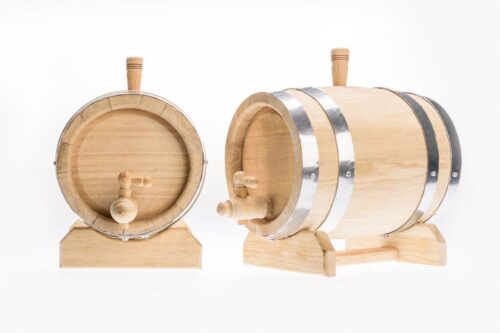Description
Brass coloured hoops, Brass spigot and Bung, Stand. Medium Charring Inside, Made from European white Oak, Outside Finish Natural.
These new virgin white oak barrels are perfect for aging cognac, brandy, whiskey, perennial wine, the production of such noble alcoholic beverages is impossible without oak barrels! This storage feature directly affects the taste of beverage: thanks to a good oak barrel, we can get a unique color and that very exquisite aroma with hints of wood, which will only improve with every year of storage!
Long-term aging in oak barrels gives the product about five hundred useful elements. Some of them affect the color, others change the taste in a special way, and some increase the shelf life of the beverage. It is the oak that provides the drink with the very bouquet of aromas that sommeliers and gourmets appreciate so much!
Toasting vs. Charring: What’s the difference?
What gives whisky its smoky taste, colour, mouth feel and aroma? The barrel specifically, the inside of the barrel.
You can get all the steps right from the very beginning — the best grains, a pristine water source, a flawless distillation process — but it’s the maturation process that gives the spirit its character. And the barrel’s interior plays a big part in that.
Why burn it?
For one thing, it’s the law when distilling spirits like bourbon — it legally has to be aged in a charred new oak barrel. But burning a barrel’s interior also primes the wood and makes it easier for the spirit to interact with different components.
Heat causes hemicellulose within the wood to break down into natural sugars, resulting in toasty caramel notes, colour and aromas, while oak lactones add woody, coconut-like notes.
When exposed to heat, tannins become less astringent while oak lignin (a fibre within the wood) breaks down into flavour molecules like eugenol (spiced/cloves) and, more famously, vanillin (vanilla).
There are two different burning procedures:
Toasting is a slower process. It involves gently heating the barrel’s interior over an open flame so that the heat can penetrate deep into the wood, which mellows and takes on a dark brown colour.
A toasted barrel is less common than a charred one, but it doesn’t mean toasting doesn’t have its advantages. You’ll get more of a spiced vanilla flavour from a toasted barrel. And without the char, your liquor will have a lighter colour and a stronger/sharper taste.
Charring is like a fast burn. Although the heat doesn’t penetrate as deeply into the wood, charring gives your barrel a burnt interior. Ever see a campfire log after the fire? That’s what the surface looks like on the inside of your barrel. It’s black with some ash residue, and that’s a good thing because the carbon in the ash is the filter that takes the edge off your liquor.
Charring also imparts darker colours and sweeter flavours than toasting because the intense heat caramelizes the wood sugars and releases more vanillins, lactones and tannins, which will leach into your spirit
It could take a few seconds or it could take a minute — the amount of time your barrel is exposed to intense heat will determine the intensity of the flavours. A barrel’s char level can range from No. 1 (medium char) to a greater char depth of No. 4, also known as “alligator char” due to its resemblance to reptile skin.
So a higher char is better, right?
Not necessarily. Your spirit will definitely take on a darker colour inside a barrel with a higher level of char. Think of it as the spirit equivalent of a dark roast coffee — a higher char yields liquor that’s big and bold, with loads of toasted notes and smoky aromas.
But there’s a trade-off: the intensity of a deeper char can mean less complexity, because compounds like lactones degrade with a longer burn time. It depends on your personal preference.
What’s inside a Barrel from Barry`s Barrel`s?






Reviews
There are no reviews yet.